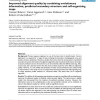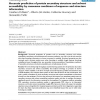6 search results - page 1 / 2 » Improved alignment quality by combining evolutionary informa... |
BMCBI
2006
13 years 4 months ago
2006
Background: Protein sequence alignment is one of the basic tools in bioinformatics. Correct alignments are required for a range of tasks including the derivation of phylogenetic t...
BMCBI
2007
13 years 4 months ago
2007
Background: Structural properties of proteins such as secondary structure and solvent accessibility contribute to three-dimensional structure prediction, not only in the ab initio...
ICASSP
2007
IEEE
13 years 11 months ago
2007
IEEE
Protein structure prediction aims to determine the three-dimensional structure of proteins form their amino acid sequences. When a protein does not have similarity (homology) to a...
CIKM
2009
Springer
13 years 11 months ago
2009
Springer
Background: Although both conservation and correlated mutation (CM) are important information reflecting the different sorts of context in multiple sequence alignment, most of ali...
IPPS
2006
IEEE
13 years 10 months ago
2006
IEEE
—Homology modeling requires an accurate alignment between a query sequence and its homologs with known three-dimensional (3D) information. Current structural modeling techniques ...


